Cycle of Continuous Improvement Assignment 2022
VerifiedAdded on 2022/10/11
|16
|4443
|15
Assignment
AI Summary
Contribute Materials
Your contribution can guide someone’s learning journey. Share your
documents today.
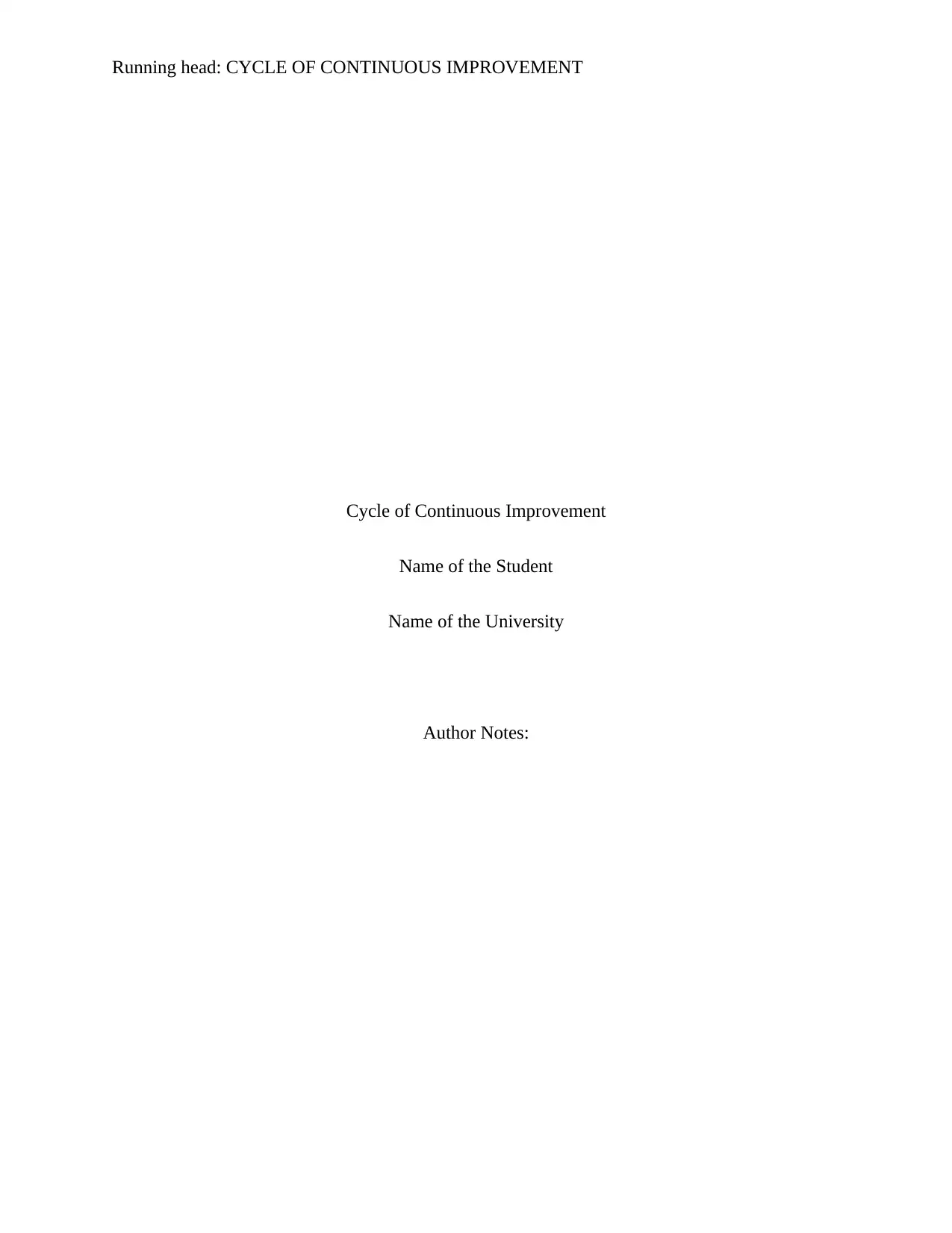
Running head: CYCLE OF CONTINUOUS IMPROVEMENT
Cycle of Continuous Improvement
Name of the Student
Name of the University
Author Notes:
Cycle of Continuous Improvement
Name of the Student
Name of the University
Author Notes:
Secure Best Marks with AI Grader
Need help grading? Try our AI Grader for instant feedback on your assignments.
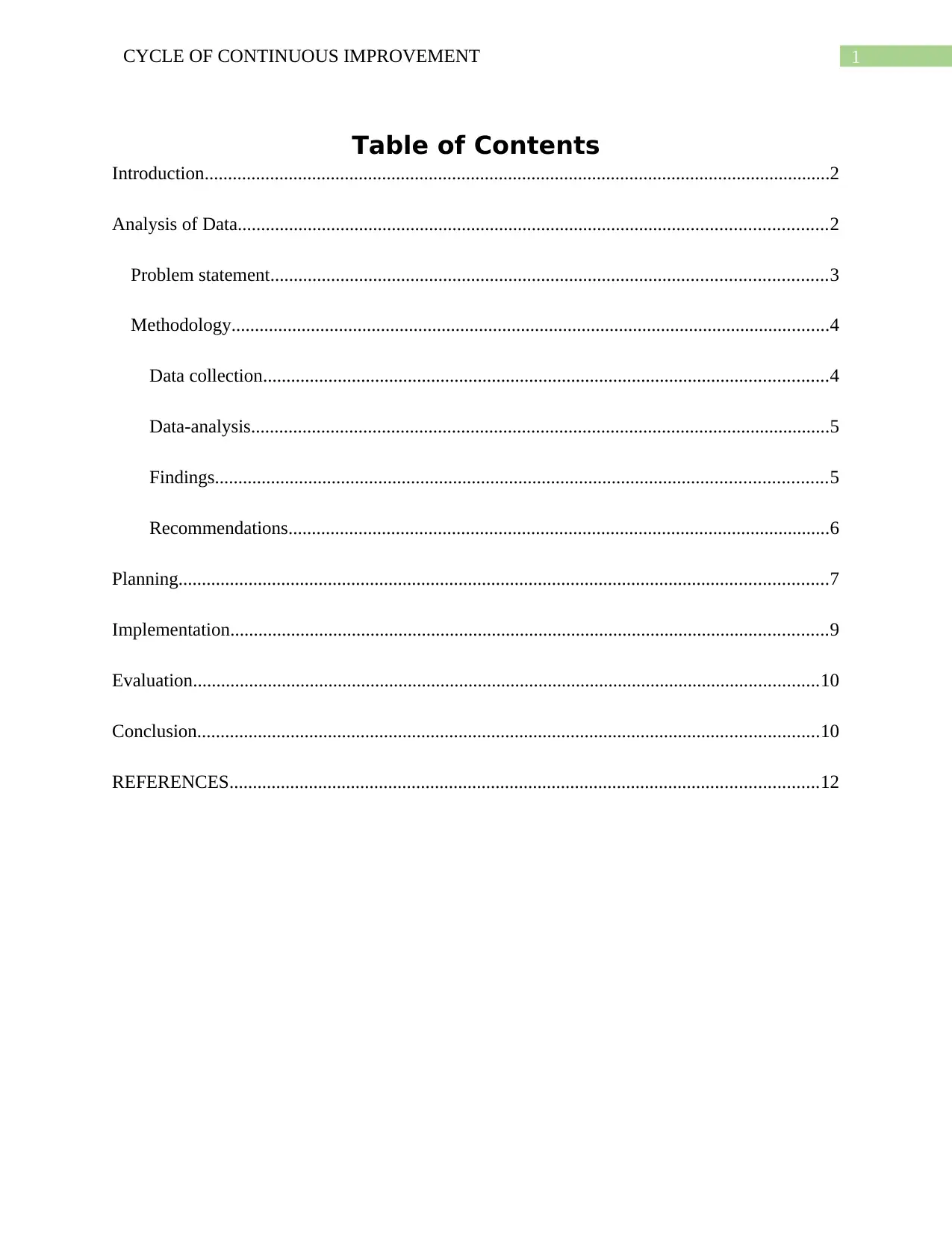
1CYCLE OF CONTINUOUS IMPROVEMENT
Table of Contents
Introduction......................................................................................................................................2
Analysis of Data..............................................................................................................................2
Problem statement.......................................................................................................................3
Methodology................................................................................................................................4
Data collection.........................................................................................................................4
Data-analysis............................................................................................................................5
Findings...................................................................................................................................5
Recommendations....................................................................................................................6
Planning...........................................................................................................................................7
Implementation................................................................................................................................9
Evaluation......................................................................................................................................10
Conclusion.....................................................................................................................................10
REFERENCES..............................................................................................................................12
Table of Contents
Introduction......................................................................................................................................2
Analysis of Data..............................................................................................................................2
Problem statement.......................................................................................................................3
Methodology................................................................................................................................4
Data collection.........................................................................................................................4
Data-analysis............................................................................................................................5
Findings...................................................................................................................................5
Recommendations....................................................................................................................6
Planning...........................................................................................................................................7
Implementation................................................................................................................................9
Evaluation......................................................................................................................................10
Conclusion.....................................................................................................................................10
REFERENCES..............................................................................................................................12
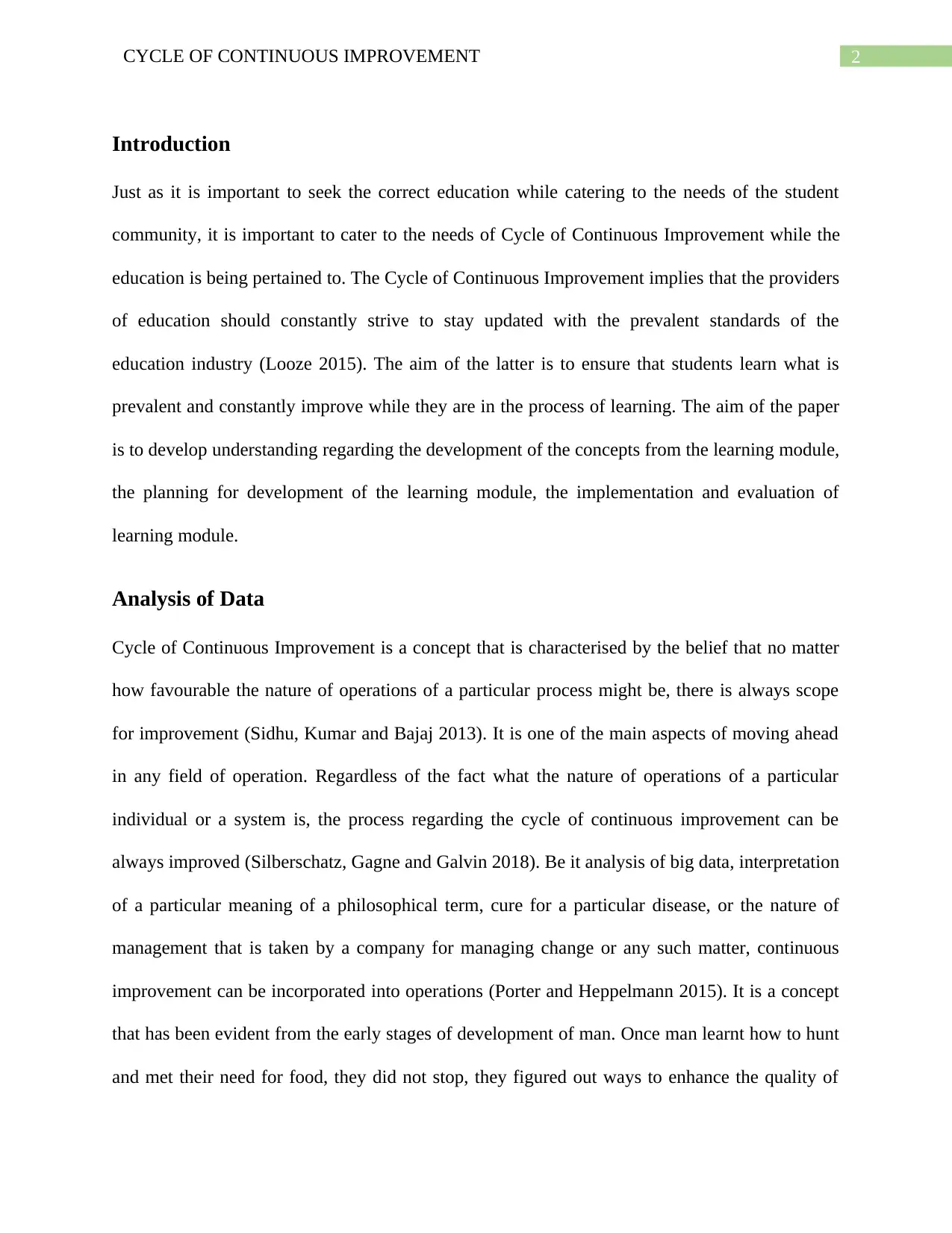
2CYCLE OF CONTINUOUS IMPROVEMENT
Introduction
Just as it is important to seek the correct education while catering to the needs of the student
community, it is important to cater to the needs of Cycle of Continuous Improvement while the
education is being pertained to. The Cycle of Continuous Improvement implies that the providers
of education should constantly strive to stay updated with the prevalent standards of the
education industry (Looze 2015). The aim of the latter is to ensure that students learn what is
prevalent and constantly improve while they are in the process of learning. The aim of the paper
is to develop understanding regarding the development of the concepts from the learning module,
the planning for development of the learning module, the implementation and evaluation of
learning module.
Analysis of Data
Cycle of Continuous Improvement is a concept that is characterised by the belief that no matter
how favourable the nature of operations of a particular process might be, there is always scope
for improvement (Sidhu, Kumar and Bajaj 2013). It is one of the main aspects of moving ahead
in any field of operation. Regardless of the fact what the nature of operations of a particular
individual or a system is, the process regarding the cycle of continuous improvement can be
always improved (Silberschatz, Gagne and Galvin 2018). Be it analysis of big data, interpretation
of a particular meaning of a philosophical term, cure for a particular disease, or the nature of
management that is taken by a company for managing change or any such matter, continuous
improvement can be incorporated into operations (Porter and Heppelmann 2015). It is a concept
that has been evident from the early stages of development of man. Once man learnt how to hunt
and met their need for food, they did not stop, they figured out ways to enhance the quality of
Introduction
Just as it is important to seek the correct education while catering to the needs of the student
community, it is important to cater to the needs of Cycle of Continuous Improvement while the
education is being pertained to. The Cycle of Continuous Improvement implies that the providers
of education should constantly strive to stay updated with the prevalent standards of the
education industry (Looze 2015). The aim of the latter is to ensure that students learn what is
prevalent and constantly improve while they are in the process of learning. The aim of the paper
is to develop understanding regarding the development of the concepts from the learning module,
the planning for development of the learning module, the implementation and evaluation of
learning module.
Analysis of Data
Cycle of Continuous Improvement is a concept that is characterised by the belief that no matter
how favourable the nature of operations of a particular process might be, there is always scope
for improvement (Sidhu, Kumar and Bajaj 2013). It is one of the main aspects of moving ahead
in any field of operation. Regardless of the fact what the nature of operations of a particular
individual or a system is, the process regarding the cycle of continuous improvement can be
always improved (Silberschatz, Gagne and Galvin 2018). Be it analysis of big data, interpretation
of a particular meaning of a philosophical term, cure for a particular disease, or the nature of
management that is taken by a company for managing change or any such matter, continuous
improvement can be incorporated into operations (Porter and Heppelmann 2015). It is a concept
that has been evident from the early stages of development of man. Once man learnt how to hunt
and met their need for food, they did not stop, they figured out ways to enhance the quality of
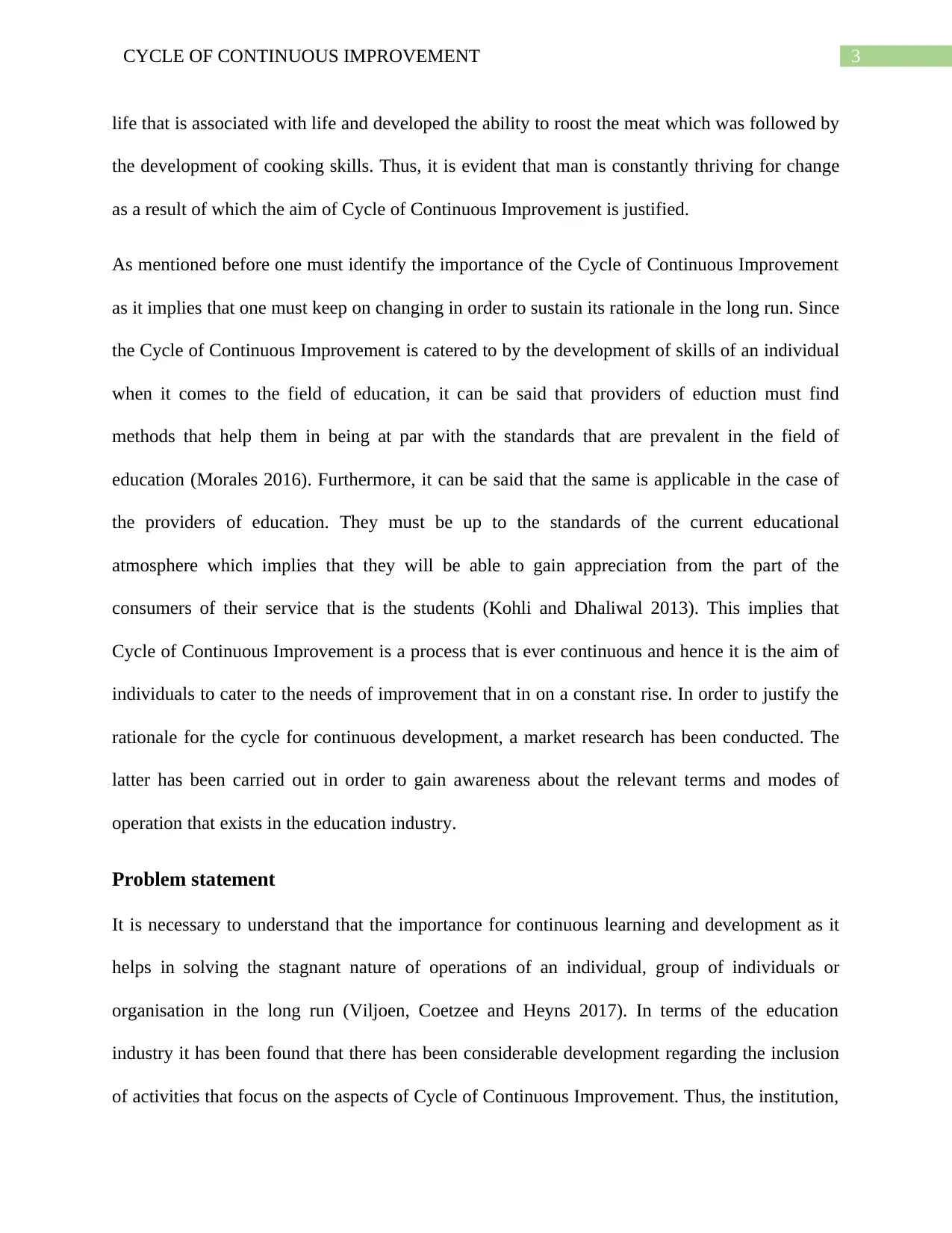
3CYCLE OF CONTINUOUS IMPROVEMENT
life that is associated with life and developed the ability to roost the meat which was followed by
the development of cooking skills. Thus, it is evident that man is constantly thriving for change
as a result of which the aim of Cycle of Continuous Improvement is justified.
As mentioned before one must identify the importance of the Cycle of Continuous Improvement
as it implies that one must keep on changing in order to sustain its rationale in the long run. Since
the Cycle of Continuous Improvement is catered to by the development of skills of an individual
when it comes to the field of education, it can be said that providers of eduction must find
methods that help them in being at par with the standards that are prevalent in the field of
education (Morales 2016). Furthermore, it can be said that the same is applicable in the case of
the providers of education. They must be up to the standards of the current educational
atmosphere which implies that they will be able to gain appreciation from the part of the
consumers of their service that is the students (Kohli and Dhaliwal 2013). This implies that
Cycle of Continuous Improvement is a process that is ever continuous and hence it is the aim of
individuals to cater to the needs of improvement that in on a constant rise. In order to justify the
rationale for the cycle for continuous development, a market research has been conducted. The
latter has been carried out in order to gain awareness about the relevant terms and modes of
operation that exists in the education industry.
Problem statement
It is necessary to understand that the importance for continuous learning and development as it
helps in solving the stagnant nature of operations of an individual, group of individuals or
organisation in the long run (Viljoen, Coetzee and Heyns 2017). In terms of the education
industry it has been found that there has been considerable development regarding the inclusion
of activities that focus on the aspects of Cycle of Continuous Improvement. Thus, the institution,
life that is associated with life and developed the ability to roost the meat which was followed by
the development of cooking skills. Thus, it is evident that man is constantly thriving for change
as a result of which the aim of Cycle of Continuous Improvement is justified.
As mentioned before one must identify the importance of the Cycle of Continuous Improvement
as it implies that one must keep on changing in order to sustain its rationale in the long run. Since
the Cycle of Continuous Improvement is catered to by the development of skills of an individual
when it comes to the field of education, it can be said that providers of eduction must find
methods that help them in being at par with the standards that are prevalent in the field of
education (Morales 2016). Furthermore, it can be said that the same is applicable in the case of
the providers of education. They must be up to the standards of the current educational
atmosphere which implies that they will be able to gain appreciation from the part of the
consumers of their service that is the students (Kohli and Dhaliwal 2013). This implies that
Cycle of Continuous Improvement is a process that is ever continuous and hence it is the aim of
individuals to cater to the needs of improvement that in on a constant rise. In order to justify the
rationale for the cycle for continuous development, a market research has been conducted. The
latter has been carried out in order to gain awareness about the relevant terms and modes of
operation that exists in the education industry.
Problem statement
It is necessary to understand that the importance for continuous learning and development as it
helps in solving the stagnant nature of operations of an individual, group of individuals or
organisation in the long run (Viljoen, Coetzee and Heyns 2017). In terms of the education
industry it has been found that there has been considerable development regarding the inclusion
of activities that focus on the aspects of Cycle of Continuous Improvement. Thus, the institution,
Secure Best Marks with AI Grader
Need help grading? Try our AI Grader for instant feedback on your assignments.
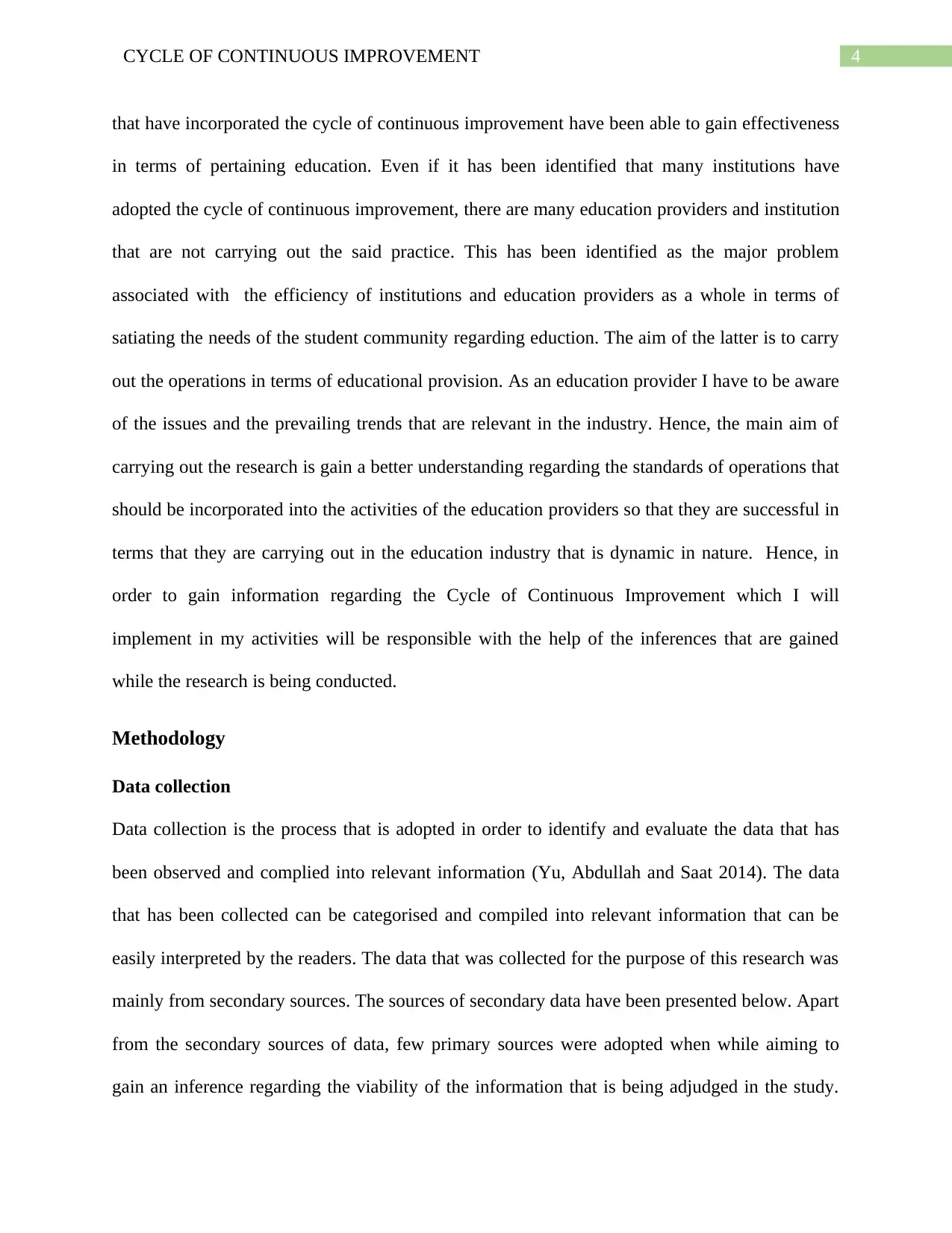
4CYCLE OF CONTINUOUS IMPROVEMENT
that have incorporated the cycle of continuous improvement have been able to gain effectiveness
in terms of pertaining education. Even if it has been identified that many institutions have
adopted the cycle of continuous improvement, there are many education providers and institution
that are not carrying out the said practice. This has been identified as the major problem
associated with the efficiency of institutions and education providers as a whole in terms of
satiating the needs of the student community regarding eduction. The aim of the latter is to carry
out the operations in terms of educational provision. As an education provider I have to be aware
of the issues and the prevailing trends that are relevant in the industry. Hence, the main aim of
carrying out the research is gain a better understanding regarding the standards of operations that
should be incorporated into the activities of the education providers so that they are successful in
terms that they are carrying out in the education industry that is dynamic in nature. Hence, in
order to gain information regarding the Cycle of Continuous Improvement which I will
implement in my activities will be responsible with the help of the inferences that are gained
while the research is being conducted.
Methodology
Data collection
Data collection is the process that is adopted in order to identify and evaluate the data that has
been observed and complied into relevant information (Yu, Abdullah and Saat 2014). The data
that has been collected can be categorised and compiled into relevant information that can be
easily interpreted by the readers. The data that was collected for the purpose of this research was
mainly from secondary sources. The sources of secondary data have been presented below. Apart
from the secondary sources of data, few primary sources were adopted when while aiming to
gain an inference regarding the viability of the information that is being adjudged in the study.
that have incorporated the cycle of continuous improvement have been able to gain effectiveness
in terms of pertaining education. Even if it has been identified that many institutions have
adopted the cycle of continuous improvement, there are many education providers and institution
that are not carrying out the said practice. This has been identified as the major problem
associated with the efficiency of institutions and education providers as a whole in terms of
satiating the needs of the student community regarding eduction. The aim of the latter is to carry
out the operations in terms of educational provision. As an education provider I have to be aware
of the issues and the prevailing trends that are relevant in the industry. Hence, the main aim of
carrying out the research is gain a better understanding regarding the standards of operations that
should be incorporated into the activities of the education providers so that they are successful in
terms that they are carrying out in the education industry that is dynamic in nature. Hence, in
order to gain information regarding the Cycle of Continuous Improvement which I will
implement in my activities will be responsible with the help of the inferences that are gained
while the research is being conducted.
Methodology
Data collection
Data collection is the process that is adopted in order to identify and evaluate the data that has
been observed and complied into relevant information (Yu, Abdullah and Saat 2014). The data
that has been collected can be categorised and compiled into relevant information that can be
easily interpreted by the readers. The data that was collected for the purpose of this research was
mainly from secondary sources. The sources of secondary data have been presented below. Apart
from the secondary sources of data, few primary sources were adopted when while aiming to
gain an inference regarding the viability of the information that is being adjudged in the study.
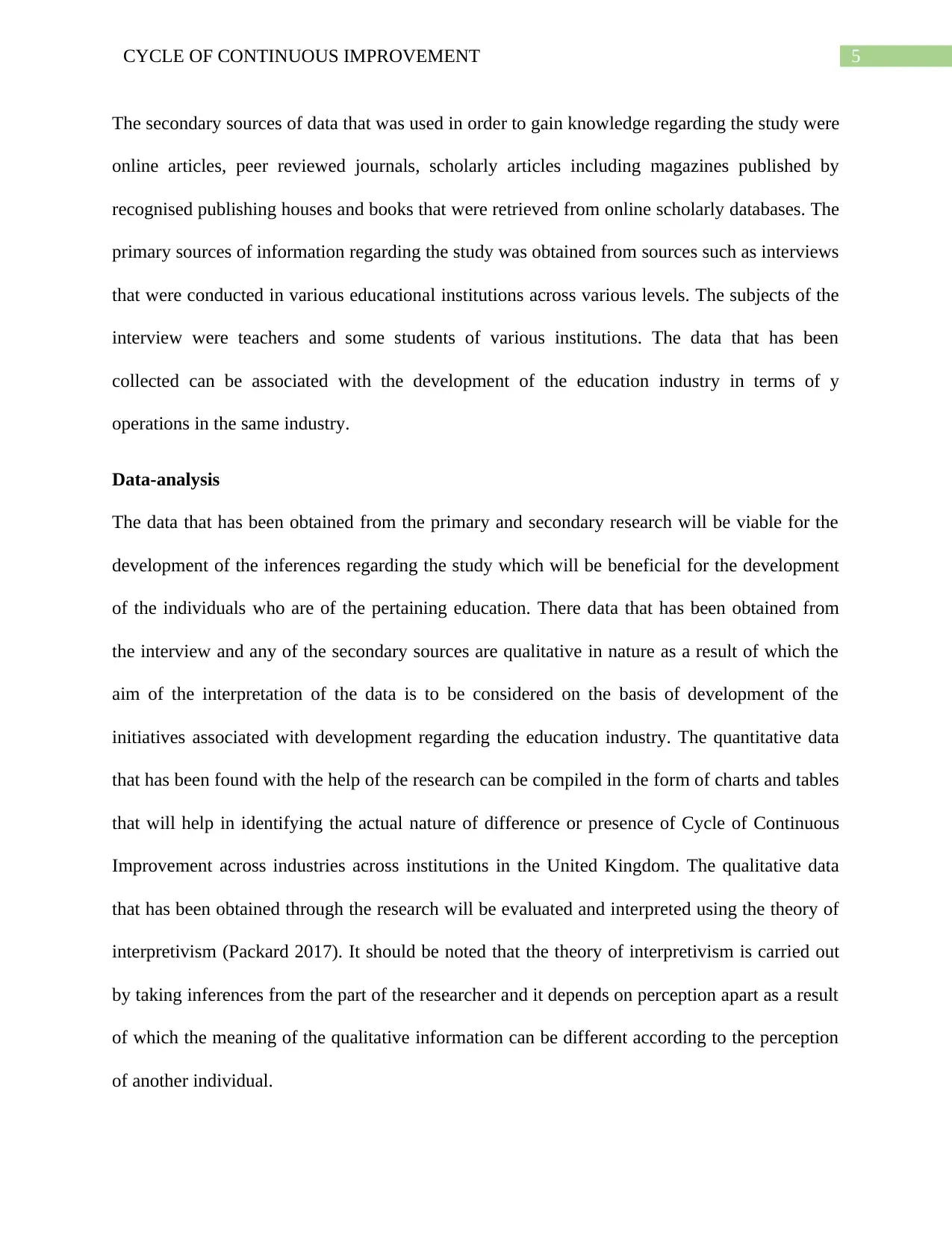
5CYCLE OF CONTINUOUS IMPROVEMENT
The secondary sources of data that was used in order to gain knowledge regarding the study were
online articles, peer reviewed journals, scholarly articles including magazines published by
recognised publishing houses and books that were retrieved from online scholarly databases. The
primary sources of information regarding the study was obtained from sources such as interviews
that were conducted in various educational institutions across various levels. The subjects of the
interview were teachers and some students of various institutions. The data that has been
collected can be associated with the development of the education industry in terms of y
operations in the same industry.
Data-analysis
The data that has been obtained from the primary and secondary research will be viable for the
development of the inferences regarding the study which will be beneficial for the development
of the individuals who are of the pertaining education. There data that has been obtained from
the interview and any of the secondary sources are qualitative in nature as a result of which the
aim of the interpretation of the data is to be considered on the basis of development of the
initiatives associated with development regarding the education industry. The quantitative data
that has been found with the help of the research can be compiled in the form of charts and tables
that will help in identifying the actual nature of difference or presence of Cycle of Continuous
Improvement across industries across institutions in the United Kingdom. The qualitative data
that has been obtained through the research will be evaluated and interpreted using the theory of
interpretivism (Packard 2017). It should be noted that the theory of interpretivism is carried out
by taking inferences from the part of the researcher and it depends on perception apart as a result
of which the meaning of the qualitative information can be different according to the perception
of another individual.
The secondary sources of data that was used in order to gain knowledge regarding the study were
online articles, peer reviewed journals, scholarly articles including magazines published by
recognised publishing houses and books that were retrieved from online scholarly databases. The
primary sources of information regarding the study was obtained from sources such as interviews
that were conducted in various educational institutions across various levels. The subjects of the
interview were teachers and some students of various institutions. The data that has been
collected can be associated with the development of the education industry in terms of y
operations in the same industry.
Data-analysis
The data that has been obtained from the primary and secondary research will be viable for the
development of the inferences regarding the study which will be beneficial for the development
of the individuals who are of the pertaining education. There data that has been obtained from
the interview and any of the secondary sources are qualitative in nature as a result of which the
aim of the interpretation of the data is to be considered on the basis of development of the
initiatives associated with development regarding the education industry. The quantitative data
that has been found with the help of the research can be compiled in the form of charts and tables
that will help in identifying the actual nature of difference or presence of Cycle of Continuous
Improvement across industries across institutions in the United Kingdom. The qualitative data
that has been obtained through the research will be evaluated and interpreted using the theory of
interpretivism (Packard 2017). It should be noted that the theory of interpretivism is carried out
by taking inferences from the part of the researcher and it depends on perception apart as a result
of which the meaning of the qualitative information can be different according to the perception
of another individual.
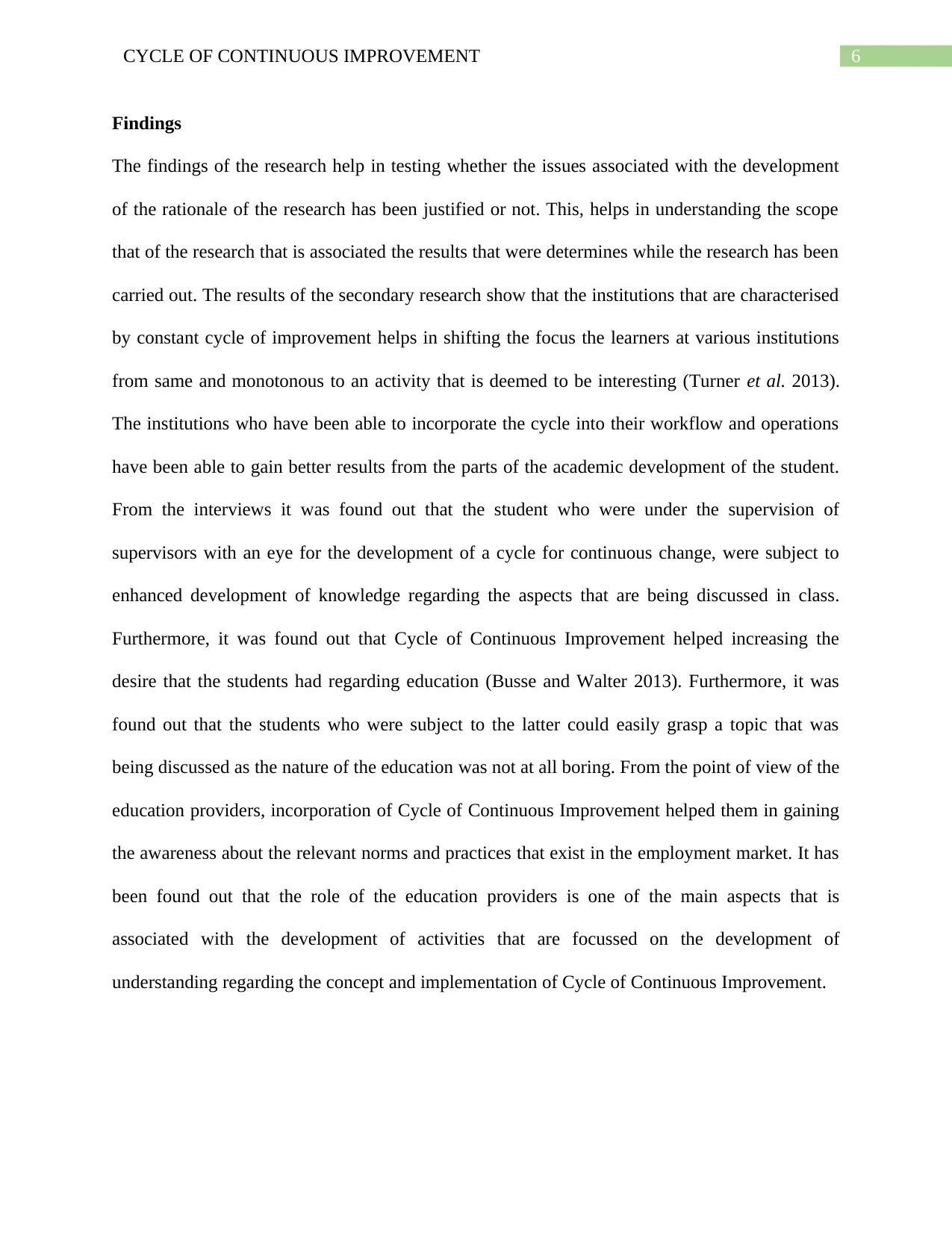
6CYCLE OF CONTINUOUS IMPROVEMENT
Findings
The findings of the research help in testing whether the issues associated with the development
of the rationale of the research has been justified or not. This, helps in understanding the scope
that of the research that is associated the results that were determines while the research has been
carried out. The results of the secondary research show that the institutions that are characterised
by constant cycle of improvement helps in shifting the focus the learners at various institutions
from same and monotonous to an activity that is deemed to be interesting (Turner et al. 2013).
The institutions who have been able to incorporate the cycle into their workflow and operations
have been able to gain better results from the parts of the academic development of the student.
From the interviews it was found out that the student who were under the supervision of
supervisors with an eye for the development of a cycle for continuous change, were subject to
enhanced development of knowledge regarding the aspects that are being discussed in class.
Furthermore, it was found out that Cycle of Continuous Improvement helped increasing the
desire that the students had regarding education (Busse and Walter 2013). Furthermore, it was
found out that the students who were subject to the latter could easily grasp a topic that was
being discussed as the nature of the education was not at all boring. From the point of view of the
education providers, incorporation of Cycle of Continuous Improvement helped them in gaining
the awareness about the relevant norms and practices that exist in the employment market. It has
been found out that the role of the education providers is one of the main aspects that is
associated with the development of activities that are focussed on the development of
understanding regarding the concept and implementation of Cycle of Continuous Improvement.
Findings
The findings of the research help in testing whether the issues associated with the development
of the rationale of the research has been justified or not. This, helps in understanding the scope
that of the research that is associated the results that were determines while the research has been
carried out. The results of the secondary research show that the institutions that are characterised
by constant cycle of improvement helps in shifting the focus the learners at various institutions
from same and monotonous to an activity that is deemed to be interesting (Turner et al. 2013).
The institutions who have been able to incorporate the cycle into their workflow and operations
have been able to gain better results from the parts of the academic development of the student.
From the interviews it was found out that the student who were under the supervision of
supervisors with an eye for the development of a cycle for continuous change, were subject to
enhanced development of knowledge regarding the aspects that are being discussed in class.
Furthermore, it was found out that Cycle of Continuous Improvement helped increasing the
desire that the students had regarding education (Busse and Walter 2013). Furthermore, it was
found out that the students who were subject to the latter could easily grasp a topic that was
being discussed as the nature of the education was not at all boring. From the point of view of the
education providers, incorporation of Cycle of Continuous Improvement helped them in gaining
the awareness about the relevant norms and practices that exist in the employment market. It has
been found out that the role of the education providers is one of the main aspects that is
associated with the development of activities that are focussed on the development of
understanding regarding the concept and implementation of Cycle of Continuous Improvement.
Paraphrase This Document
Need a fresh take? Get an instant paraphrase of this document with our AI Paraphraser
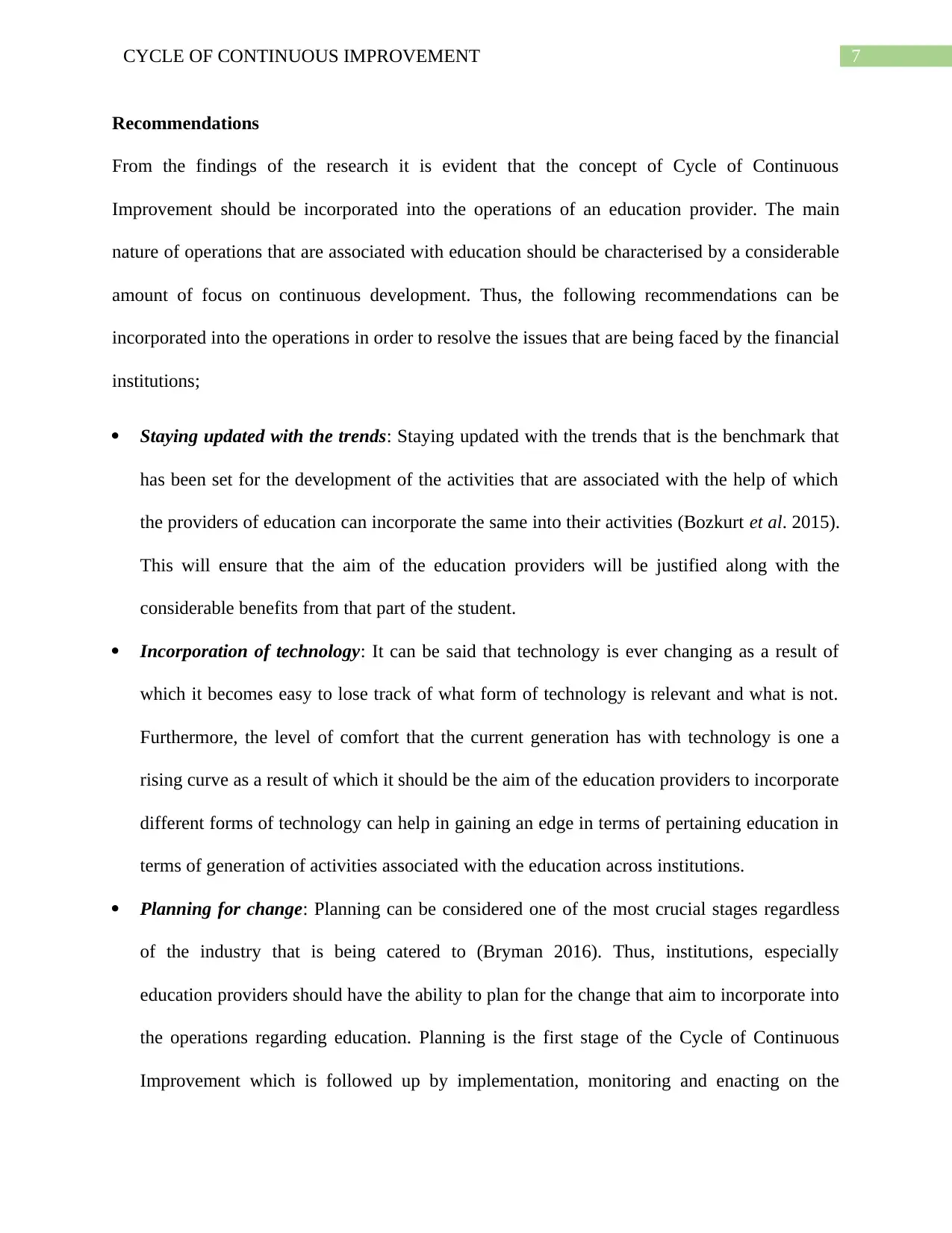
7CYCLE OF CONTINUOUS IMPROVEMENT
Recommendations
From the findings of the research it is evident that the concept of Cycle of Continuous
Improvement should be incorporated into the operations of an education provider. The main
nature of operations that are associated with education should be characterised by a considerable
amount of focus on continuous development. Thus, the following recommendations can be
incorporated into the operations in order to resolve the issues that are being faced by the financial
institutions;
Staying updated with the trends: Staying updated with the trends that is the benchmark that
has been set for the development of the activities that are associated with the help of which
the providers of education can incorporate the same into their activities (Bozkurt et al. 2015).
This will ensure that the aim of the education providers will be justified along with the
considerable benefits from that part of the student.
Incorporation of technology: It can be said that technology is ever changing as a result of
which it becomes easy to lose track of what form of technology is relevant and what is not.
Furthermore, the level of comfort that the current generation has with technology is one a
rising curve as a result of which it should be the aim of the education providers to incorporate
different forms of technology can help in gaining an edge in terms of pertaining education in
terms of generation of activities associated with the education across institutions.
Planning for change: Planning can be considered one of the most crucial stages regardless
of the industry that is being catered to (Bryman 2016). Thus, institutions, especially
education providers should have the ability to plan for the change that aim to incorporate into
the operations regarding education. Planning is the first stage of the Cycle of Continuous
Improvement which is followed up by implementation, monitoring and enacting on the
Recommendations
From the findings of the research it is evident that the concept of Cycle of Continuous
Improvement should be incorporated into the operations of an education provider. The main
nature of operations that are associated with education should be characterised by a considerable
amount of focus on continuous development. Thus, the following recommendations can be
incorporated into the operations in order to resolve the issues that are being faced by the financial
institutions;
Staying updated with the trends: Staying updated with the trends that is the benchmark that
has been set for the development of the activities that are associated with the help of which
the providers of education can incorporate the same into their activities (Bozkurt et al. 2015).
This will ensure that the aim of the education providers will be justified along with the
considerable benefits from that part of the student.
Incorporation of technology: It can be said that technology is ever changing as a result of
which it becomes easy to lose track of what form of technology is relevant and what is not.
Furthermore, the level of comfort that the current generation has with technology is one a
rising curve as a result of which it should be the aim of the education providers to incorporate
different forms of technology can help in gaining an edge in terms of pertaining education in
terms of generation of activities associated with the education across institutions.
Planning for change: Planning can be considered one of the most crucial stages regardless
of the industry that is being catered to (Bryman 2016). Thus, institutions, especially
education providers should have the ability to plan for the change that aim to incorporate into
the operations regarding education. Planning is the first stage of the Cycle of Continuous
Improvement which is followed up by implementation, monitoring and enacting on the
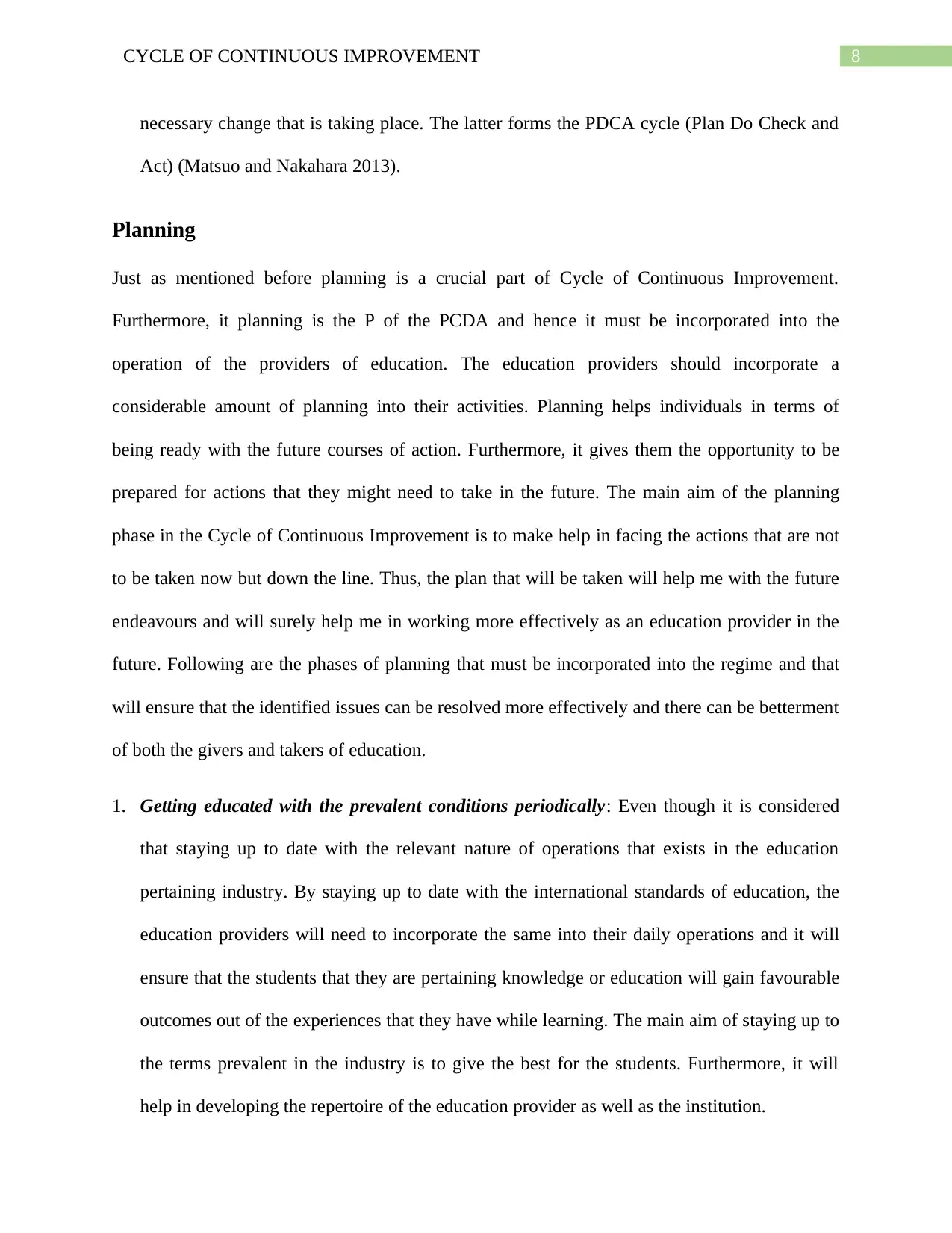
8CYCLE OF CONTINUOUS IMPROVEMENT
necessary change that is taking place. The latter forms the PDCA cycle (Plan Do Check and
Act) (Matsuo and Nakahara 2013).
Planning
Just as mentioned before planning is a crucial part of Cycle of Continuous Improvement.
Furthermore, it planning is the P of the PCDA and hence it must be incorporated into the
operation of the providers of education. The education providers should incorporate a
considerable amount of planning into their activities. Planning helps individuals in terms of
being ready with the future courses of action. Furthermore, it gives them the opportunity to be
prepared for actions that they might need to take in the future. The main aim of the planning
phase in the Cycle of Continuous Improvement is to make help in facing the actions that are not
to be taken now but down the line. Thus, the plan that will be taken will help me with the future
endeavours and will surely help me in working more effectively as an education provider in the
future. Following are the phases of planning that must be incorporated into the regime and that
will ensure that the identified issues can be resolved more effectively and there can be betterment
of both the givers and takers of education.
1. Getting educated with the prevalent conditions periodically: Even though it is considered
that staying up to date with the relevant nature of operations that exists in the education
pertaining industry. By staying up to date with the international standards of education, the
education providers will need to incorporate the same into their daily operations and it will
ensure that the students that they are pertaining knowledge or education will gain favourable
outcomes out of the experiences that they have while learning. The main aim of staying up to
the terms prevalent in the industry is to give the best for the students. Furthermore, it will
help in developing the repertoire of the education provider as well as the institution.
necessary change that is taking place. The latter forms the PDCA cycle (Plan Do Check and
Act) (Matsuo and Nakahara 2013).
Planning
Just as mentioned before planning is a crucial part of Cycle of Continuous Improvement.
Furthermore, it planning is the P of the PCDA and hence it must be incorporated into the
operation of the providers of education. The education providers should incorporate a
considerable amount of planning into their activities. Planning helps individuals in terms of
being ready with the future courses of action. Furthermore, it gives them the opportunity to be
prepared for actions that they might need to take in the future. The main aim of the planning
phase in the Cycle of Continuous Improvement is to make help in facing the actions that are not
to be taken now but down the line. Thus, the plan that will be taken will help me with the future
endeavours and will surely help me in working more effectively as an education provider in the
future. Following are the phases of planning that must be incorporated into the regime and that
will ensure that the identified issues can be resolved more effectively and there can be betterment
of both the givers and takers of education.
1. Getting educated with the prevalent conditions periodically: Even though it is considered
that staying up to date with the relevant nature of operations that exists in the education
pertaining industry. By staying up to date with the international standards of education, the
education providers will need to incorporate the same into their daily operations and it will
ensure that the students that they are pertaining knowledge or education will gain favourable
outcomes out of the experiences that they have while learning. The main aim of staying up to
the terms prevalent in the industry is to give the best for the students. Furthermore, it will
help in developing the repertoire of the education provider as well as the institution.
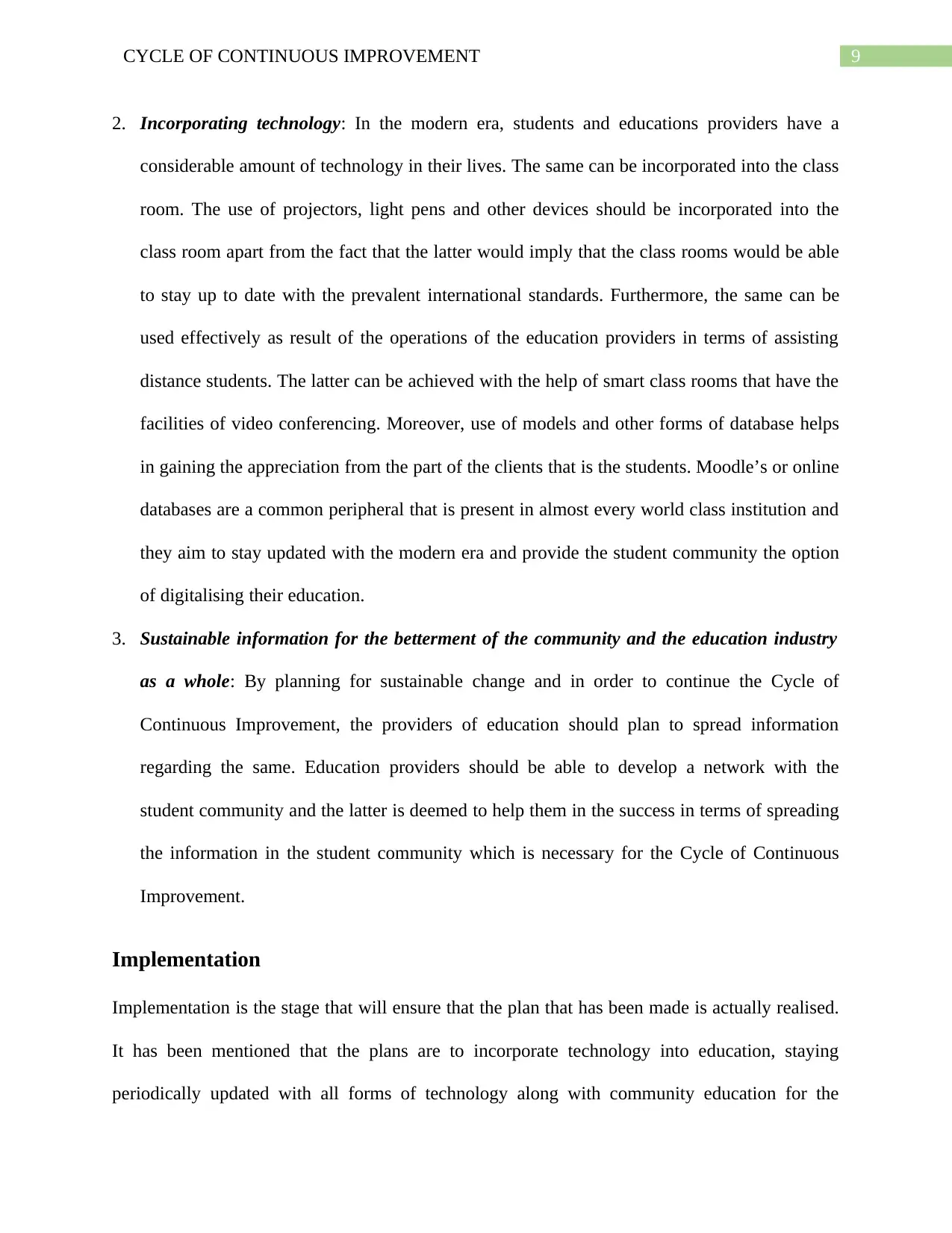
9CYCLE OF CONTINUOUS IMPROVEMENT
2. Incorporating technology: In the modern era, students and educations providers have a
considerable amount of technology in their lives. The same can be incorporated into the class
room. The use of projectors, light pens and other devices should be incorporated into the
class room apart from the fact that the latter would imply that the class rooms would be able
to stay up to date with the prevalent international standards. Furthermore, the same can be
used effectively as result of the operations of the education providers in terms of assisting
distance students. The latter can be achieved with the help of smart class rooms that have the
facilities of video conferencing. Moreover, use of models and other forms of database helps
in gaining the appreciation from the part of the clients that is the students. Moodle’s or online
databases are a common peripheral that is present in almost every world class institution and
they aim to stay updated with the modern era and provide the student community the option
of digitalising their education.
3. Sustainable information for the betterment of the community and the education industry
as a whole: By planning for sustainable change and in order to continue the Cycle of
Continuous Improvement, the providers of education should plan to spread information
regarding the same. Education providers should be able to develop a network with the
student community and the latter is deemed to help them in the success in terms of spreading
the information in the student community which is necessary for the Cycle of Continuous
Improvement.
Implementation
Implementation is the stage that will ensure that the plan that has been made is actually realised.
It has been mentioned that the plans are to incorporate technology into education, staying
periodically updated with all forms of technology along with community education for the
2. Incorporating technology: In the modern era, students and educations providers have a
considerable amount of technology in their lives. The same can be incorporated into the class
room. The use of projectors, light pens and other devices should be incorporated into the
class room apart from the fact that the latter would imply that the class rooms would be able
to stay up to date with the prevalent international standards. Furthermore, the same can be
used effectively as result of the operations of the education providers in terms of assisting
distance students. The latter can be achieved with the help of smart class rooms that have the
facilities of video conferencing. Moreover, use of models and other forms of database helps
in gaining the appreciation from the part of the clients that is the students. Moodle’s or online
databases are a common peripheral that is present in almost every world class institution and
they aim to stay updated with the modern era and provide the student community the option
of digitalising their education.
3. Sustainable information for the betterment of the community and the education industry
as a whole: By planning for sustainable change and in order to continue the Cycle of
Continuous Improvement, the providers of education should plan to spread information
regarding the same. Education providers should be able to develop a network with the
student community and the latter is deemed to help them in the success in terms of spreading
the information in the student community which is necessary for the Cycle of Continuous
Improvement.
Implementation
Implementation is the stage that will ensure that the plan that has been made is actually realised.
It has been mentioned that the plans are to incorporate technology into education, staying
periodically updated with all forms of technology along with community education for the
Secure Best Marks with AI Grader
Need help grading? Try our AI Grader for instant feedback on your assignments.
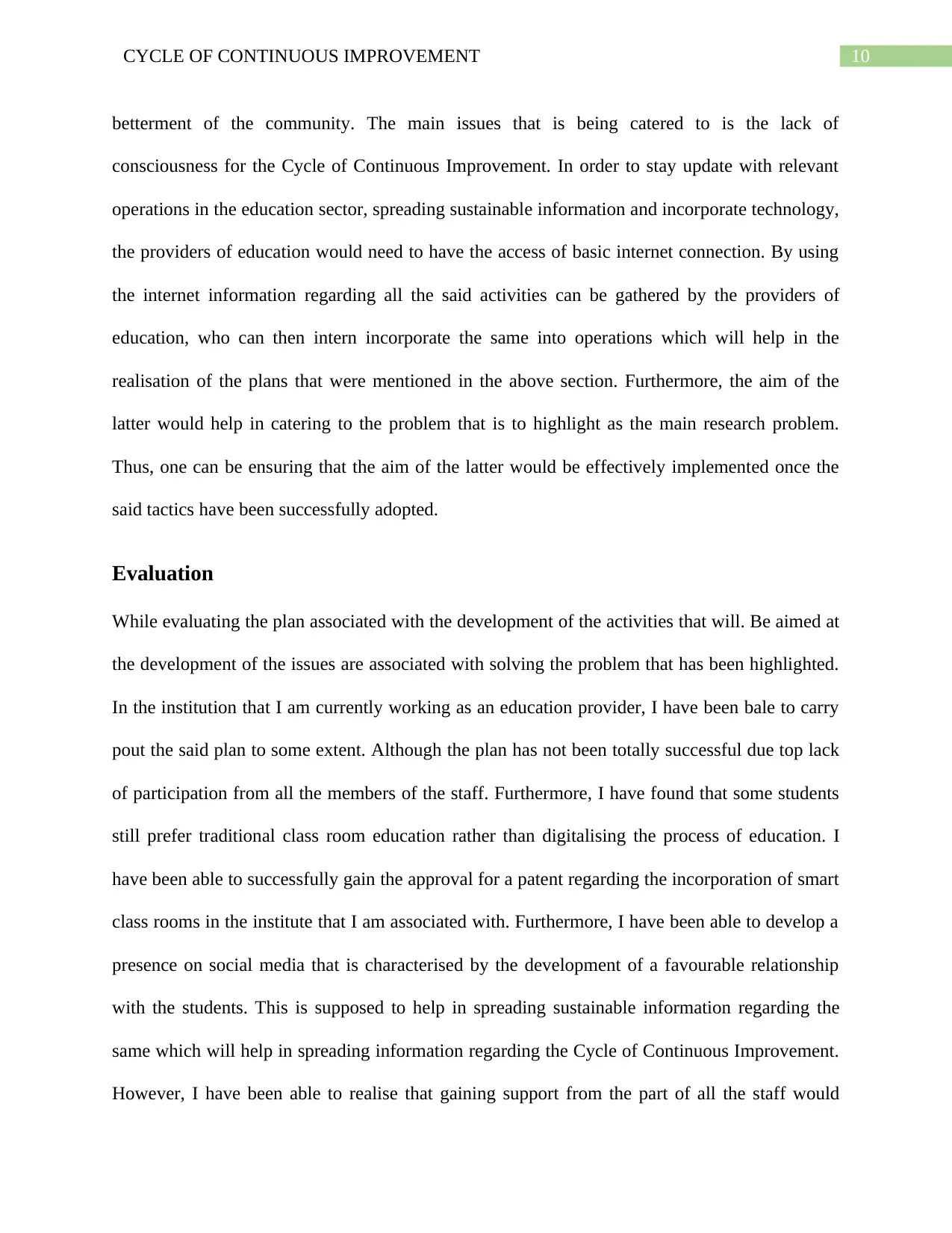
10CYCLE OF CONTINUOUS IMPROVEMENT
betterment of the community. The main issues that is being catered to is the lack of
consciousness for the Cycle of Continuous Improvement. In order to stay update with relevant
operations in the education sector, spreading sustainable information and incorporate technology,
the providers of education would need to have the access of basic internet connection. By using
the internet information regarding all the said activities can be gathered by the providers of
education, who can then intern incorporate the same into operations which will help in the
realisation of the plans that were mentioned in the above section. Furthermore, the aim of the
latter would help in catering to the problem that is to highlight as the main research problem.
Thus, one can be ensuring that the aim of the latter would be effectively implemented once the
said tactics have been successfully adopted.
Evaluation
While evaluating the plan associated with the development of the activities that will. Be aimed at
the development of the issues are associated with solving the problem that has been highlighted.
In the institution that I am currently working as an education provider, I have been bale to carry
pout the said plan to some extent. Although the plan has not been totally successful due top lack
of participation from all the members of the staff. Furthermore, I have found that some students
still prefer traditional class room education rather than digitalising the process of education. I
have been able to successfully gain the approval for a patent regarding the incorporation of smart
class rooms in the institute that I am associated with. Furthermore, I have been able to develop a
presence on social media that is characterised by the development of a favourable relationship
with the students. This is supposed to help in spreading sustainable information regarding the
same which will help in spreading information regarding the Cycle of Continuous Improvement.
However, I have been able to realise that gaining support from the part of all the staff would
betterment of the community. The main issues that is being catered to is the lack of
consciousness for the Cycle of Continuous Improvement. In order to stay update with relevant
operations in the education sector, spreading sustainable information and incorporate technology,
the providers of education would need to have the access of basic internet connection. By using
the internet information regarding all the said activities can be gathered by the providers of
education, who can then intern incorporate the same into operations which will help in the
realisation of the plans that were mentioned in the above section. Furthermore, the aim of the
latter would help in catering to the problem that is to highlight as the main research problem.
Thus, one can be ensuring that the aim of the latter would be effectively implemented once the
said tactics have been successfully adopted.
Evaluation
While evaluating the plan associated with the development of the activities that will. Be aimed at
the development of the issues are associated with solving the problem that has been highlighted.
In the institution that I am currently working as an education provider, I have been bale to carry
pout the said plan to some extent. Although the plan has not been totally successful due top lack
of participation from all the members of the staff. Furthermore, I have found that some students
still prefer traditional class room education rather than digitalising the process of education. I
have been able to successfully gain the approval for a patent regarding the incorporation of smart
class rooms in the institute that I am associated with. Furthermore, I have been able to develop a
presence on social media that is characterised by the development of a favourable relationship
with the students. This is supposed to help in spreading sustainable information regarding the
same which will help in spreading information regarding the Cycle of Continuous Improvement.
However, I have been able to realise that gaining support from the part of all the staff would
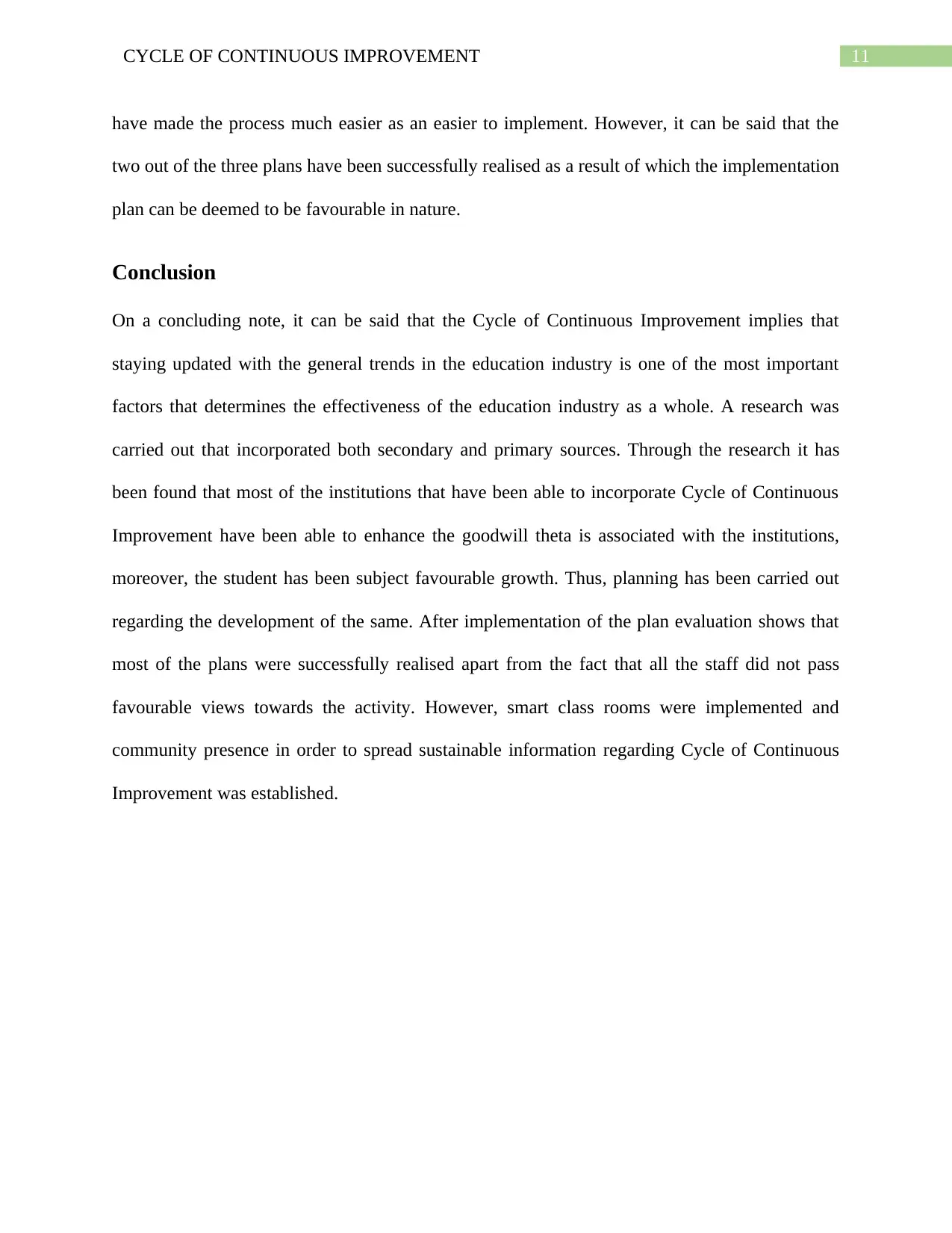
11CYCLE OF CONTINUOUS IMPROVEMENT
have made the process much easier as an easier to implement. However, it can be said that the
two out of the three plans have been successfully realised as a result of which the implementation
plan can be deemed to be favourable in nature.
Conclusion
On a concluding note, it can be said that the Cycle of Continuous Improvement implies that
staying updated with the general trends in the education industry is one of the most important
factors that determines the effectiveness of the education industry as a whole. A research was
carried out that incorporated both secondary and primary sources. Through the research it has
been found that most of the institutions that have been able to incorporate Cycle of Continuous
Improvement have been able to enhance the goodwill theta is associated with the institutions,
moreover, the student has been subject favourable growth. Thus, planning has been carried out
regarding the development of the same. After implementation of the plan evaluation shows that
most of the plans were successfully realised apart from the fact that all the staff did not pass
favourable views towards the activity. However, smart class rooms were implemented and
community presence in order to spread sustainable information regarding Cycle of Continuous
Improvement was established.
have made the process much easier as an easier to implement. However, it can be said that the
two out of the three plans have been successfully realised as a result of which the implementation
plan can be deemed to be favourable in nature.
Conclusion
On a concluding note, it can be said that the Cycle of Continuous Improvement implies that
staying updated with the general trends in the education industry is one of the most important
factors that determines the effectiveness of the education industry as a whole. A research was
carried out that incorporated both secondary and primary sources. Through the research it has
been found that most of the institutions that have been able to incorporate Cycle of Continuous
Improvement have been able to enhance the goodwill theta is associated with the institutions,
moreover, the student has been subject favourable growth. Thus, planning has been carried out
regarding the development of the same. After implementation of the plan evaluation shows that
most of the plans were successfully realised apart from the fact that all the staff did not pass
favourable views towards the activity. However, smart class rooms were implemented and
community presence in order to spread sustainable information regarding Cycle of Continuous
Improvement was established.
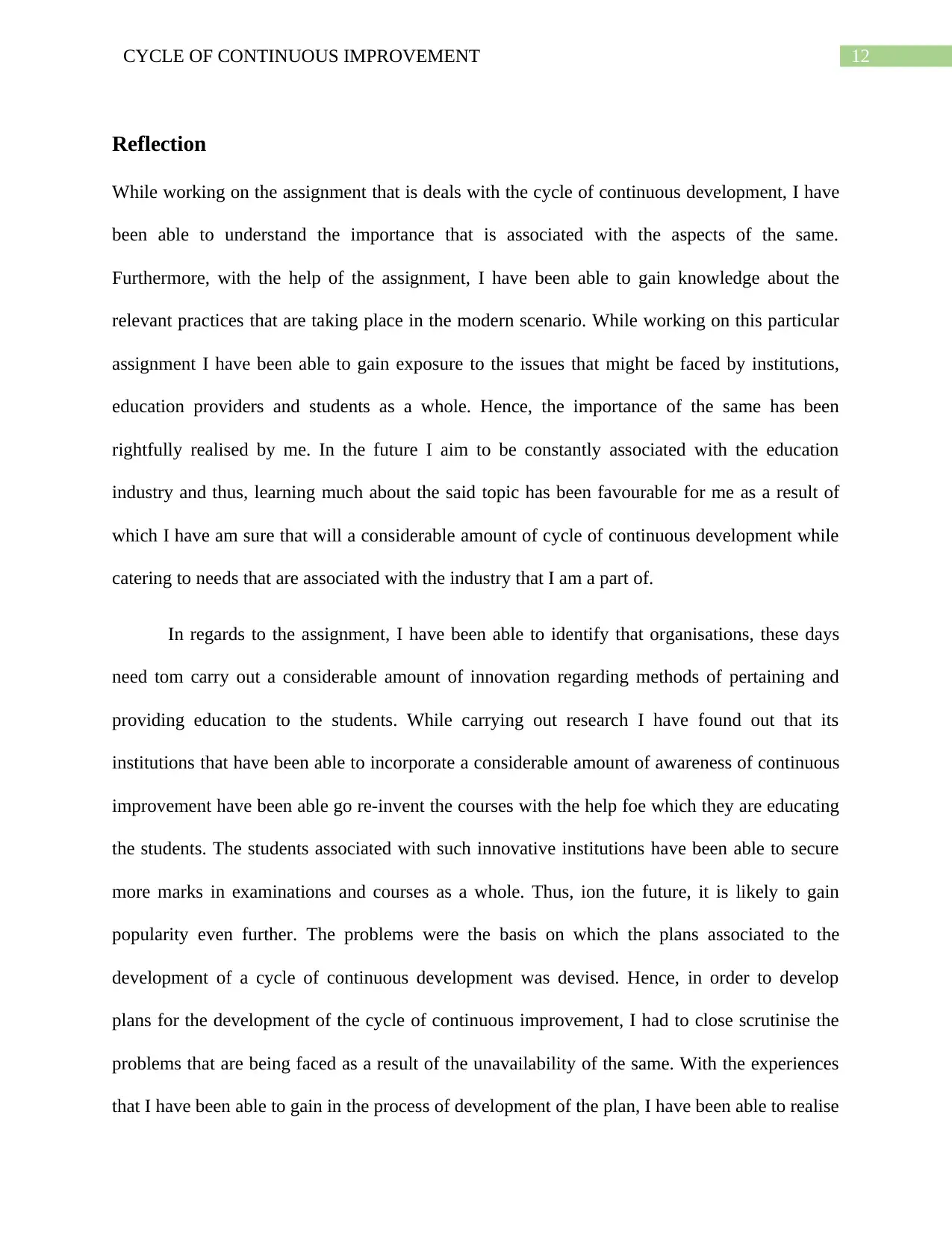
12CYCLE OF CONTINUOUS IMPROVEMENT
Reflection
While working on the assignment that is deals with the cycle of continuous development, I have
been able to understand the importance that is associated with the aspects of the same.
Furthermore, with the help of the assignment, I have been able to gain knowledge about the
relevant practices that are taking place in the modern scenario. While working on this particular
assignment I have been able to gain exposure to the issues that might be faced by institutions,
education providers and students as a whole. Hence, the importance of the same has been
rightfully realised by me. In the future I aim to be constantly associated with the education
industry and thus, learning much about the said topic has been favourable for me as a result of
which I have am sure that will a considerable amount of cycle of continuous development while
catering to needs that are associated with the industry that I am a part of.
In regards to the assignment, I have been able to identify that organisations, these days
need tom carry out a considerable amount of innovation regarding methods of pertaining and
providing education to the students. While carrying out research I have found out that its
institutions that have been able to incorporate a considerable amount of awareness of continuous
improvement have been able go re-invent the courses with the help foe which they are educating
the students. The students associated with such innovative institutions have been able to secure
more marks in examinations and courses as a whole. Thus, ion the future, it is likely to gain
popularity even further. The problems were the basis on which the plans associated to the
development of a cycle of continuous development was devised. Hence, in order to develop
plans for the development of the cycle of continuous improvement, I had to close scrutinise the
problems that are being faced as a result of the unavailability of the same. With the experiences
that I have been able to gain in the process of development of the plan, I have been able to realise
Reflection
While working on the assignment that is deals with the cycle of continuous development, I have
been able to understand the importance that is associated with the aspects of the same.
Furthermore, with the help of the assignment, I have been able to gain knowledge about the
relevant practices that are taking place in the modern scenario. While working on this particular
assignment I have been able to gain exposure to the issues that might be faced by institutions,
education providers and students as a whole. Hence, the importance of the same has been
rightfully realised by me. In the future I aim to be constantly associated with the education
industry and thus, learning much about the said topic has been favourable for me as a result of
which I have am sure that will a considerable amount of cycle of continuous development while
catering to needs that are associated with the industry that I am a part of.
In regards to the assignment, I have been able to identify that organisations, these days
need tom carry out a considerable amount of innovation regarding methods of pertaining and
providing education to the students. While carrying out research I have found out that its
institutions that have been able to incorporate a considerable amount of awareness of continuous
improvement have been able go re-invent the courses with the help foe which they are educating
the students. The students associated with such innovative institutions have been able to secure
more marks in examinations and courses as a whole. Thus, ion the future, it is likely to gain
popularity even further. The problems were the basis on which the plans associated to the
development of a cycle of continuous development was devised. Hence, in order to develop
plans for the development of the cycle of continuous improvement, I had to close scrutinise the
problems that are being faced as a result of the unavailability of the same. With the experiences
that I have been able to gain in the process of development of the plan, I have been able to realise
Paraphrase This Document
Need a fresh take? Get an instant paraphrase of this document with our AI Paraphraser
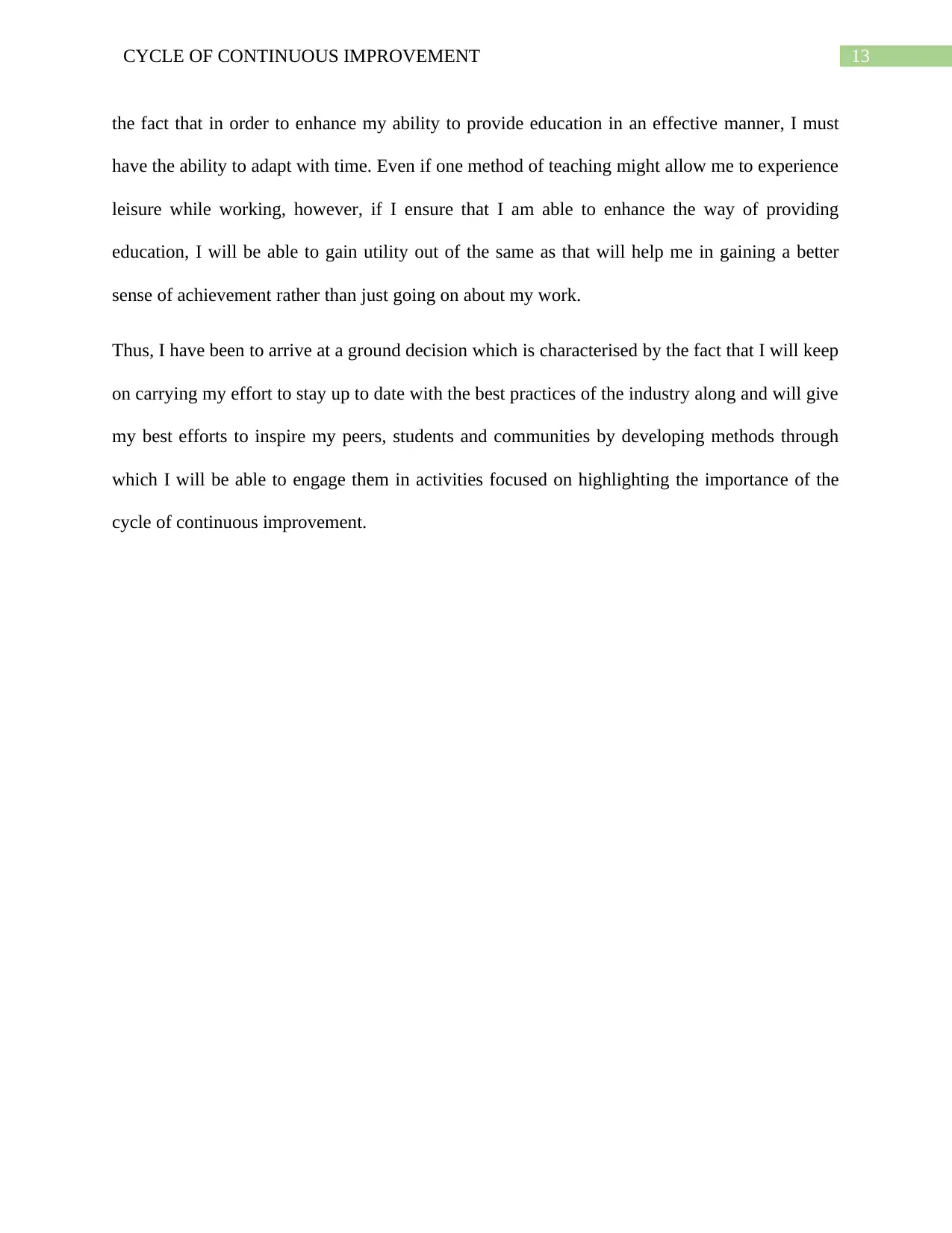
13CYCLE OF CONTINUOUS IMPROVEMENT
the fact that in order to enhance my ability to provide education in an effective manner, I must
have the ability to adapt with time. Even if one method of teaching might allow me to experience
leisure while working, however, if I ensure that I am able to enhance the way of providing
education, I will be able to gain utility out of the same as that will help me in gaining a better
sense of achievement rather than just going on about my work.
Thus, I have been to arrive at a ground decision which is characterised by the fact that I will keep
on carrying my effort to stay up to date with the best practices of the industry along and will give
my best efforts to inspire my peers, students and communities by developing methods through
which I will be able to engage them in activities focused on highlighting the importance of the
cycle of continuous improvement.
the fact that in order to enhance my ability to provide education in an effective manner, I must
have the ability to adapt with time. Even if one method of teaching might allow me to experience
leisure while working, however, if I ensure that I am able to enhance the way of providing
education, I will be able to gain utility out of the same as that will help me in gaining a better
sense of achievement rather than just going on about my work.
Thus, I have been to arrive at a ground decision which is characterised by the fact that I will keep
on carrying my effort to stay up to date with the best practices of the industry along and will give
my best efforts to inspire my peers, students and communities by developing methods through
which I will be able to engage them in activities focused on highlighting the importance of the
cycle of continuous improvement.
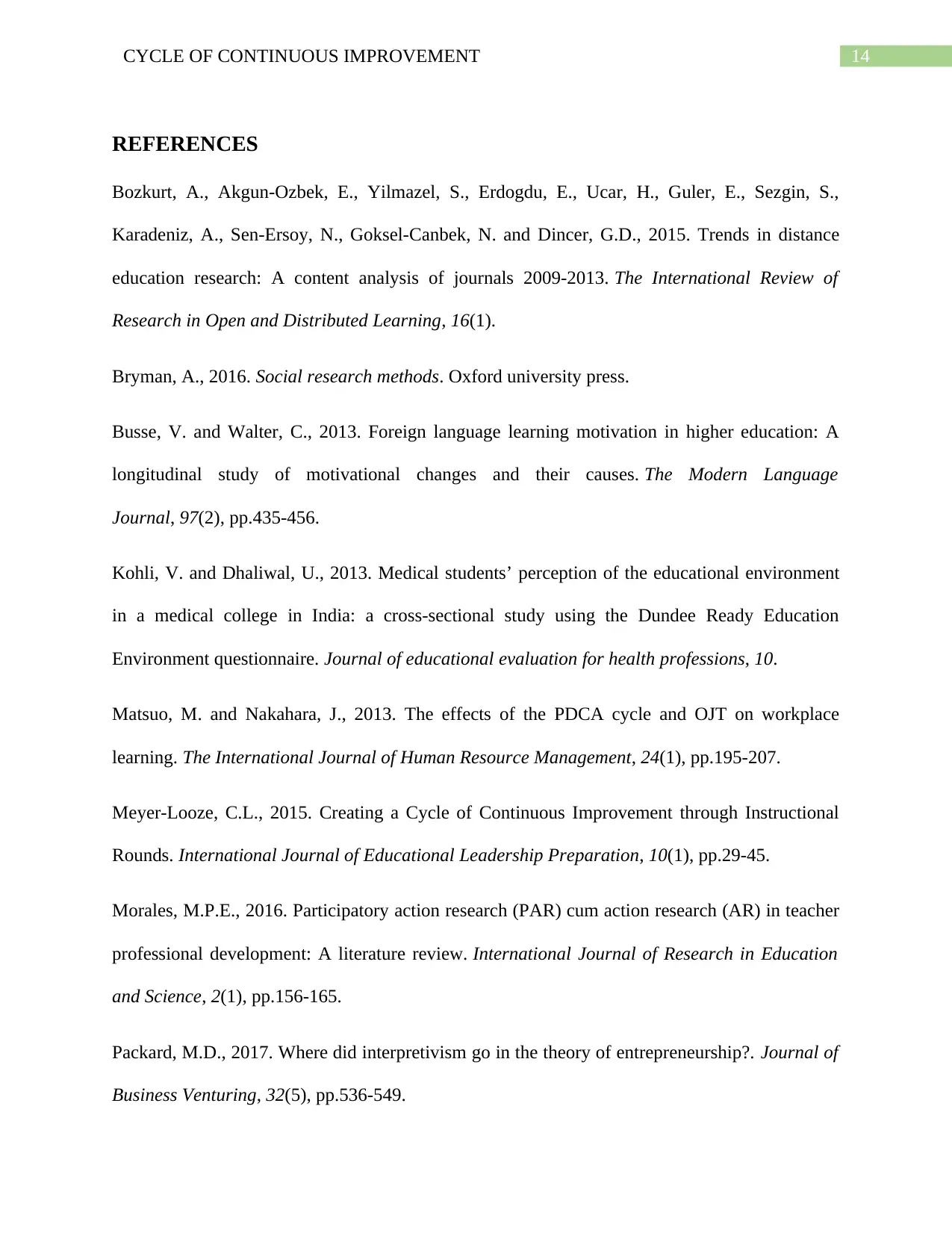
14CYCLE OF CONTINUOUS IMPROVEMENT
REFERENCES
Bozkurt, A., Akgun-Ozbek, E., Yilmazel, S., Erdogdu, E., Ucar, H., Guler, E., Sezgin, S.,
Karadeniz, A., Sen-Ersoy, N., Goksel-Canbek, N. and Dincer, G.D., 2015. Trends in distance
education research: A content analysis of journals 2009-2013. The International Review of
Research in Open and Distributed Learning, 16(1).
Bryman, A., 2016. Social research methods. Oxford university press.
Busse, V. and Walter, C., 2013. Foreign language learning motivation in higher education: A
longitudinal study of motivational changes and their causes. The Modern Language
Journal, 97(2), pp.435-456.
Kohli, V. and Dhaliwal, U., 2013. Medical students’ perception of the educational environment
in a medical college in India: a cross-sectional study using the Dundee Ready Education
Environment questionnaire. Journal of educational evaluation for health professions, 10.
Matsuo, M. and Nakahara, J., 2013. The effects of the PDCA cycle and OJT on workplace
learning. The International Journal of Human Resource Management, 24(1), pp.195-207.
Meyer-Looze, C.L., 2015. Creating a Cycle of Continuous Improvement through Instructional
Rounds. International Journal of Educational Leadership Preparation, 10(1), pp.29-45.
Morales, M.P.E., 2016. Participatory action research (PAR) cum action research (AR) in teacher
professional development: A literature review. International Journal of Research in Education
and Science, 2(1), pp.156-165.
Packard, M.D., 2017. Where did interpretivism go in the theory of entrepreneurship?. Journal of
Business Venturing, 32(5), pp.536-549.
REFERENCES
Bozkurt, A., Akgun-Ozbek, E., Yilmazel, S., Erdogdu, E., Ucar, H., Guler, E., Sezgin, S.,
Karadeniz, A., Sen-Ersoy, N., Goksel-Canbek, N. and Dincer, G.D., 2015. Trends in distance
education research: A content analysis of journals 2009-2013. The International Review of
Research in Open and Distributed Learning, 16(1).
Bryman, A., 2016. Social research methods. Oxford university press.
Busse, V. and Walter, C., 2013. Foreign language learning motivation in higher education: A
longitudinal study of motivational changes and their causes. The Modern Language
Journal, 97(2), pp.435-456.
Kohli, V. and Dhaliwal, U., 2013. Medical students’ perception of the educational environment
in a medical college in India: a cross-sectional study using the Dundee Ready Education
Environment questionnaire. Journal of educational evaluation for health professions, 10.
Matsuo, M. and Nakahara, J., 2013. The effects of the PDCA cycle and OJT on workplace
learning. The International Journal of Human Resource Management, 24(1), pp.195-207.
Meyer-Looze, C.L., 2015. Creating a Cycle of Continuous Improvement through Instructional
Rounds. International Journal of Educational Leadership Preparation, 10(1), pp.29-45.
Morales, M.P.E., 2016. Participatory action research (PAR) cum action research (AR) in teacher
professional development: A literature review. International Journal of Research in Education
and Science, 2(1), pp.156-165.
Packard, M.D., 2017. Where did interpretivism go in the theory of entrepreneurship?. Journal of
Business Venturing, 32(5), pp.536-549.
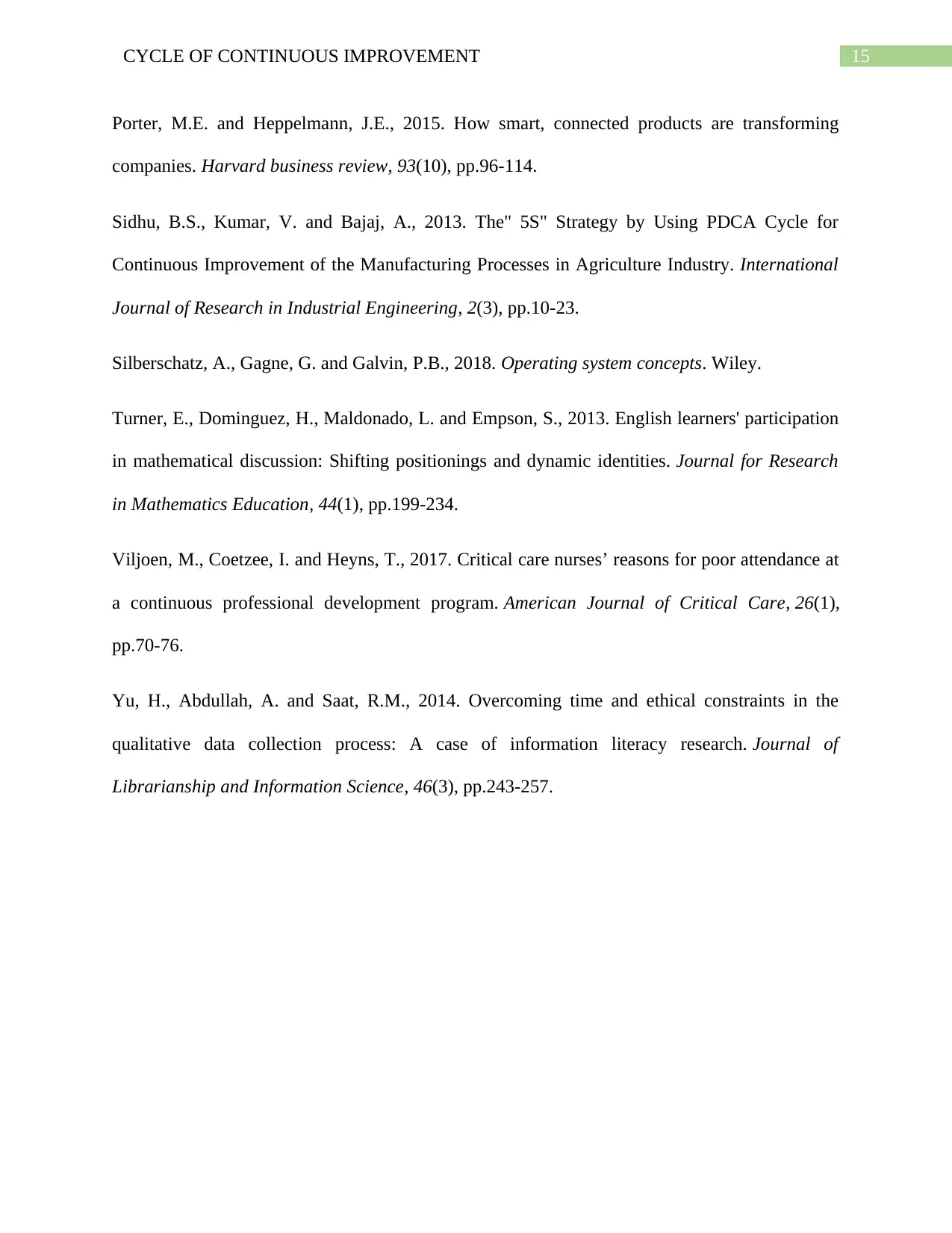
15CYCLE OF CONTINUOUS IMPROVEMENT
Porter, M.E. and Heppelmann, J.E., 2015. How smart, connected products are transforming
companies. Harvard business review, 93(10), pp.96-114.
Sidhu, B.S., Kumar, V. and Bajaj, A., 2013. The" 5S" Strategy by Using PDCA Cycle for
Continuous Improvement of the Manufacturing Processes in Agriculture Industry. International
Journal of Research in Industrial Engineering, 2(3), pp.10-23.
Silberschatz, A., Gagne, G. and Galvin, P.B., 2018. Operating system concepts. Wiley.
Turner, E., Dominguez, H., Maldonado, L. and Empson, S., 2013. English learners' participation
in mathematical discussion: Shifting positionings and dynamic identities. Journal for Research
in Mathematics Education, 44(1), pp.199-234.
Viljoen, M., Coetzee, I. and Heyns, T., 2017. Critical care nurses’ reasons for poor attendance at
a continuous professional development program. American Journal of Critical Care, 26(1),
pp.70-76.
Yu, H., Abdullah, A. and Saat, R.M., 2014. Overcoming time and ethical constraints in the
qualitative data collection process: A case of information literacy research. Journal of
Librarianship and Information Science, 46(3), pp.243-257.
Porter, M.E. and Heppelmann, J.E., 2015. How smart, connected products are transforming
companies. Harvard business review, 93(10), pp.96-114.
Sidhu, B.S., Kumar, V. and Bajaj, A., 2013. The" 5S" Strategy by Using PDCA Cycle for
Continuous Improvement of the Manufacturing Processes in Agriculture Industry. International
Journal of Research in Industrial Engineering, 2(3), pp.10-23.
Silberschatz, A., Gagne, G. and Galvin, P.B., 2018. Operating system concepts. Wiley.
Turner, E., Dominguez, H., Maldonado, L. and Empson, S., 2013. English learners' participation
in mathematical discussion: Shifting positionings and dynamic identities. Journal for Research
in Mathematics Education, 44(1), pp.199-234.
Viljoen, M., Coetzee, I. and Heyns, T., 2017. Critical care nurses’ reasons for poor attendance at
a continuous professional development program. American Journal of Critical Care, 26(1),
pp.70-76.
Yu, H., Abdullah, A. and Saat, R.M., 2014. Overcoming time and ethical constraints in the
qualitative data collection process: A case of information literacy research. Journal of
Librarianship and Information Science, 46(3), pp.243-257.
1 out of 16
Related Documents
Your All-in-One AI-Powered Toolkit for Academic Success.
+13062052269
info@desklib.com
Available 24*7 on WhatsApp / Email
![[object Object]](/_next/static/media/star-bottom.7253800d.svg)
Unlock your academic potential
© 2024 | Zucol Services PVT LTD | All rights reserved.




